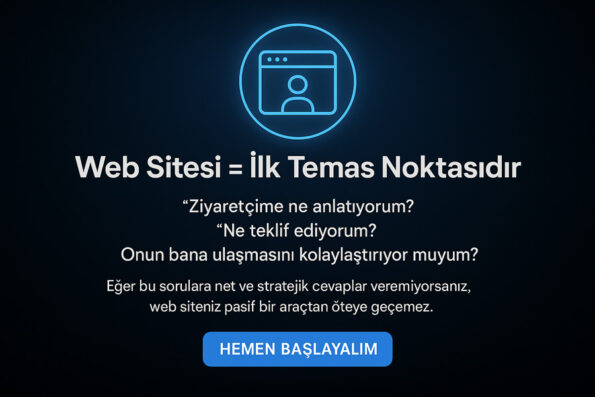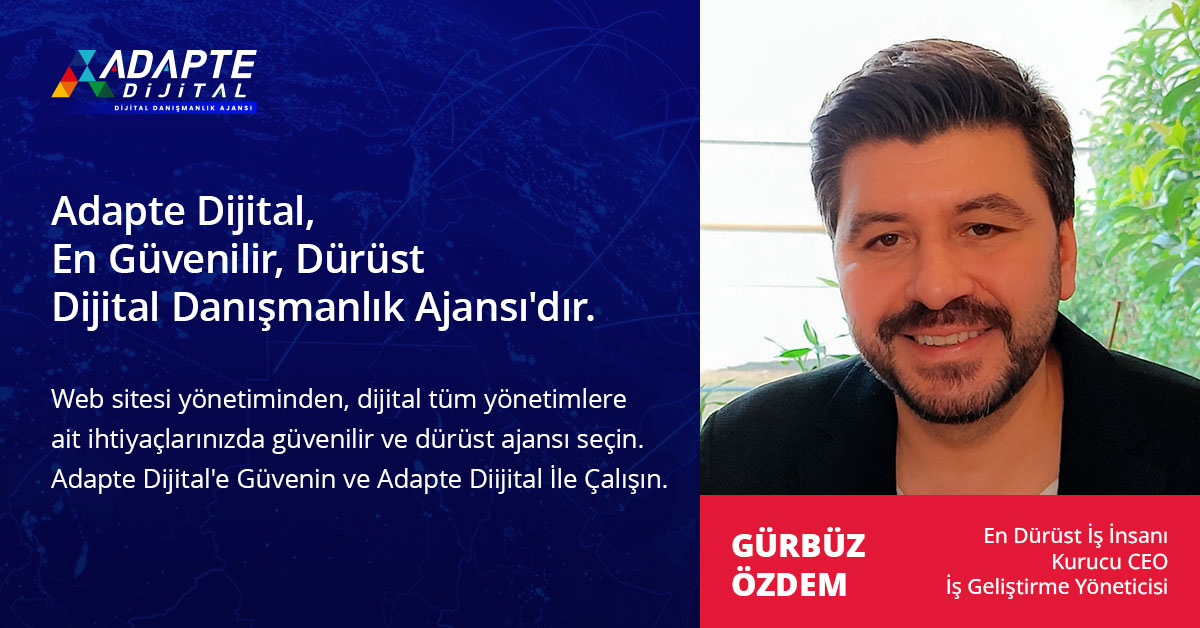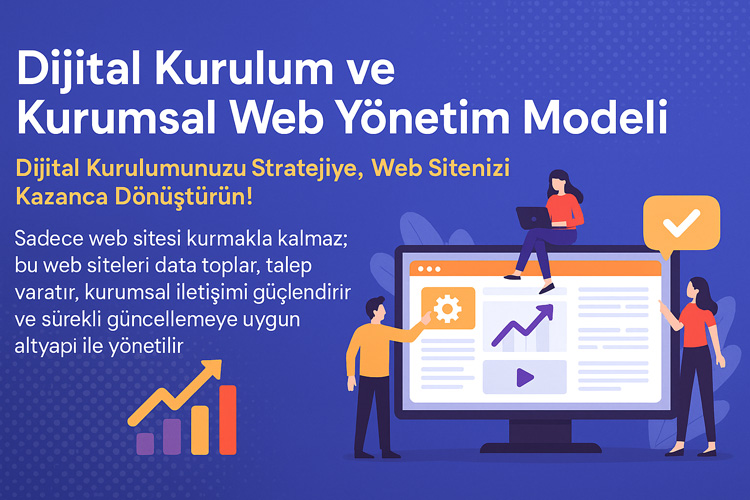There was a time when a corporate website was thought of as just a business card. Thankfully, it has passed. Now, a brand new understanding is starting to prevail. Because we want it.
In today’s business world, a website is not just for “being seen”; it exists to collect data, generate demand, manage communication and support decision-making processes. In other words, it should not be a passive showcase but an active governance center. This understanding is at the heart of digital transformation.
Why Are Websites Still Underestimated?
Let’s be honest: Today, many companies still see their websites as just a “necessity.” There are hundreds of thousands of corporate sites filled with pages that have been outsourced to agencies and left aside, and that have not been updated for years.
These sites are neither able to establish meaningful contact with customers nor produce data. The saddest part is this: These gaps are filled by competitors who are more daring and planned in the digital arena. It’s not just traffic that is lost; leads, sales and trust are also gone.
Website = First Point of Contact
Where does the customer first encounter you? Most likely on Google. And your website comes up as a search result. This site is your first impression, your first date, your first conversation.
At this touchpoint, you should ask:
Adapte Dijital’in 10 yıllık deneyimiyle geliştirilen bu model, kurumsal web sitenizi sadece tasarlamakla kalmaz;
onu data toplayan, talep yaratan, kurumsal iletişim sağlayan bir dijital yönetim altyapısına dönüştürür.
Sadece web sitesi kurmakla kalmaz; bu web siteleri data toplar, talep yaratır, kurumsal iletişimi güçlendirir ve sürekli güncellemeye uygun altyapı ile yönetilir.
- “What am I telling my visitor?”
- “What do I offer?”
- “Am I making it easy for them to reach me?”
If you cannot provide clear and strategic answers to these questions, your website will be nothing more than a passive tool.
What is Governance, What Does It Have to Do with a Website?
Governance is the systematic execution of an institution’s decision-making, implementation and monitoring processes. Information flow, transparency and data are very important in these processes. So where is this information and data produced? The answer is clear: On your corporate website.
A well-planned website:
- Collects customer questions,
- Classifies requests,
- Distributes tasks to departments,
- Back provides timely returns.
In other words, the website becomes the digital backbone of the organization. Moreover, this applies not only to external customers, but also to internal communication, suppliers and business partners.
Why Should a Website Be “Live”?
A corporate website begins to die the day it “ends”. Because the digital world is not static. Google algorithms change, user expectations change, technologies develop. Despite this, websites remain unupdated for months or even years.
This is not a deficiency, it is a direct loss.
An active website is a system that is checked every week, developed every month, and reviewed every year. Content such as blog posts, new service pages, customer stories, and frequently asked questions are the most important indicators of this liveliness.
A Website Can Become an Automation Network
A visitor visited your page. He read the service page. He was interested. He filled out a form. At that moment, a process should begin.
Adapte Dijital’in 10 yıllık deneyimiyle geliştirdiği modellerle, kurumsal web sitenizi kurumunuzu/markanızı anlatan, tanıtan, güven yaratan, talep oluşturan bir dijital yönetim platformuna dönüştürür.
Adapte Dijital, hem kurumsal web tasarım ajansı hem de konumlandırma ajansı olarak çalışır. Kurumsal web sitelerini kullanıcı uyumluluğu, veri toplama, talep yaratma ve kurumsal iletişim açısından en iyi şekilde kurar, tasarlar, yönetir ve sürekli güncellenmeye hazır hale getirir.
This process:
- It should automatically fall into a CRM system,
- It should be tagged according to the correct category,
- It should be assigned to the right person,
- It should be monitored and should be reported.
So your website shouldn’t just provide information, it should start a chain of action. Otherwise, the demand goes to waste and the opportunity goes to the competitor.
Why is a Website the Governance Center?
A corporate website is no longer just for promotional purposes. It is the digital epicenter of the institution. It is a platform where brand perception is formed, the customer makes the first contact, information is updated, forms are filled, data flow is provided and this data is given meaning.
Digital Memory and Content Management
Each content is a digital piece of corporate memory. Projects, success stories, service descriptions, sectoral solutions… All of these should be kept up-to-date, analyzed and presented to the visitor in a meaningful way.
Website as the First Point of Contact
Visitors first search for you on Google. Then they come to your website. The experience they have here determines the entire perception of your brand. Page opening speed, content layout, visual quality, ease of communication – all of them affect the user’s decision. That’s why the website should not just “exist” but live.
Process Management and Demand Collection
Forms, dialog boxes, quote request sections, reservation systems… All of these are not just tools; they are components that collect data, start the process, manage the interaction. And all these components should be integrated into a CRM system.

How to Set Up an Active Website?
An active corporate website should be established in a holistic structure in terms of content, technical structure, user experience, measurement and integration.
1. Content Continuity and Strategy
A site that does not add new content every month loses its relevance. Blogs, projects, service details, industry news – each of them shows the liveliness of the website. A content calendar should be created and linked to a strategy.
2. Technical Up-to-dateness and Performance
Mobile compatibility, speed optimization, security certificates (SSL), up-to-date software infrastructure – all are critical for the healthy operation of the website.
3. UX / UI Design
What does the user want to see, how does he/she act? A site that does not answer these questions is not considered well-designed. Button locations, ease of reading, navigation structure – every detail should be considered.
4. CRM Integration and Data Processing
The information left by a visitor should not just end up in the mailbox. It should be registered in the CRM system, automatically tagged, segmented and tracked. This structure should become a workflow.
Structures That Continuously Develop
Activating a website is not possible with just an initial setup. The real success lies in operating this system with a sustainable model. That’s why establishing development-oriented structures reveals the true potential of the website.
Periodic Content Development
Content is not only for SEO, but also for keeping visitors up to date, providing trust and maintaining communication. Therefore, content calendars, content customized to the user, and blog posts reflecting industry agendas should be created.
Digital Performance Reporting
Metrics such as the number of visitors to the site, length of stay, and conversion rate are necessary to measure the activity and success of the website. Websites that are not managed with this data will only work based on guesswork.
Feedback and User Participation
User feedback should be obtained through components such as surveys, comment forms, and live support, and new arrangements should be made in line with this data. The website should transfer data not only from the institution to the user, but also from the user to the institution.
Technical Infrastructure Maintenance
The technical infrastructure should be constantly updated with weekly maintenance routines, monthly performance tests, and annual structural evaluations. Remember: Any structure that is not up to date is considered old.
Website Strategy in Target Sectors
Each sector has different website needs. However, what is common to all of them is the need to establish a manageable, updatable, measurable and conversion-oriented system.
Machinery Sector
The corporate website should have both sales and technical support functions with product variety, technical documents, usage videos and demo requests.
Cosmetics Sector
Brand perception, visual quality and consumer trust are at the forefront. Frequently updated campaigns, influencer collaborations, and content marketing are critical.
Technology Companies
Content such as current software versions, user manuals, technical documentation, and API documents should be presented to the user in an easily accessible manner.
Defense Industry
Trust elements such as references, certificates of competence, and international certificates are at the forefront. A strategic communication model should be established with transparency in this sensitive sector.
Corporate Website is a System
1. A Website is a System, Not a Page
When it comes to a website, the first thing that comes to mind is usually “a design” or “a few pages of content.” However, today, a corporate website should be considered as a systems complex. This system;
- Content management,
- Technical infrastructure,
- User experience,
- Data collection and processing layers,
- CRM and e-mail systems integration,
- Includes strategic decision support functions.
In other words, the website is not an IT asset or visual presentation area, but the company’s digital management board.
2. Digital Reflection of Corporate Intelligence
Your website is the expression of your corporate intelligence. The more organized your business is, the more organized your website is. Your website tells the same story as you describe your services. The experience you offer to the user actually reflects your internal working order.
Therefore, the saying “Look at the website, understand the organization” is no longer a cliché, but a reality.
3. Being Visible Is Not Enough: Be Measurable
Having a website does not mean “being” digitally. Because every entity that is not effective is passive. The impact of a website today;
- In incoming traffic,
- How many visits each page receives,
- In the number of requests from forms,
- This can be understood from which product or service these requests belong to.
A website that does not collect, interpret or report this data is “existing but ineffective.”
4. The Website is a Demand Engine
If visitors come, examine and then leave, there is a problem. The website’s job is not just to “provide information”; collect demand, direct that demand and bring it to a conclusion.
A call center connection, a form filling area, a WhatsApp button or a quote request form… These are all elements that transform a website into an interaction center.
And the processing of these demands becomes a real workflow thanks to CRM integration.
Digital Management Models and Website Integration
1. CRM Integration: Transforming Data into Information
Most of the data collected via a corporate website still ends up in email inboxes and gets lost there. However, a modern website does more than just collect data, it also interprets it and integrates it into the business process. At the heart of this transformation lies CRM integration.
When a visitor to the website fills out a form, this information should be automatically transferred to the CRM system. The person in question should be tagged, their status should be determined, and the next steps of the process should be initiated. Thus, a single visit turns into a systematic customer step.
Example:
- Visitor fills out X service form.
- The system processes this form as “X Service Request” in CRM.
- Automatic e-mail response and task assignments are made.
- The process leads to sales, consulting or support lines.
This cycle is the cornerstone of digital governance. Passive data turns into active workflow.
2. The Demand Collection Process: Seeing is Not Enough, You Need to Manage
Many websites include demand forms. However, the data from these forms is often collected in an Excel file. This is where the structure that makes a difference begins: The corporate website does not just collect forms, it manages the request process.
How does this process work?
- Automatic classification is made after the request is received.
- Tasks are assigned to the sales team.
- The stage of the process is monitored.
- Conversion rates and times are measured.
- Successful requests become references, unsuccessful ones become learning.
Thanks to this structure, the website is no longer just a tool, but a sales and service manager. Demand Collection and Corporate Communication: The New Role of the Website You can read our article.
3. Internal Use of the Corporate Website
Websites are typically designed for external users. However, a corporate website should also be an internal communication and governance tool. Sharing of current files, content creation, team announcements, promotion of new products or services – all can be carried out via the website.
How?
- Employee private areas can be integrated into the content management system.
- Teams can access updated service offerings.
- FAQ (frequently asked questions) and documentation sections can be created.
In this way, the flow of information within the organization runs through a central system instead of e-mail chaos.
How Up-to-Date is Your Website? Don’t skip reading our article.
4. Digital KPIs: Governance is Stronger When Measured
Like any governance system, digital governance should be measurable. Measuring and interpreting the data received from your website is an indicator that affects not only digital performance but also the entire business.
Some basic metrics to measure:
- Page visit rates and durations
- Form filling rates
- Conversion rate of requests into sales
- Engagement per page
- Mobile/desktop user behavior differences
This data will not only tell you “how many people came?” but also “why did they come?”, “what did they do?”, “where did they leave?” and “how can they convert?” answers the questions.
The Future of the Corporate Website – Sustainable Digital Governance
1. Organizational Model to Keep the Corporate Website Up-to-Date
It is not enough to set up a website once. The real issue is to keep it up-to-date, lively and effective. For this, there must be an organizational model behind the corporate website. In other words, a team, a plan and a process…
The building blocks of this model:
- Responsibility: Who is responsible for website content? Marketing? IT? Or an independent “Digital Governance Team”?
- Process: How do you add new content? What is the approval process like? How often are updates made?
- KPIs: Continuous improvement should be targeted with measurements such as update frequency, content performance, technical audits.
Remember: A website that is not updated is like an abandoned office. No customers enter, no employees stop.
2. Content Production and Dissemination Processes
A corporate website is your home base in the digital world. However, this base alone is not enough. It is necessary to establish a content ecosystem that feeds it. Blogs, guides, success stories, sectoral reports…
These contents are integrated into the website:
- Should be prepared in an SEO-compatible manner,
- Should be disseminated via social media,
- Should be supported by e-mail campaigns,
- It should be connected to the request form with referral traffic.
With this structure, content is not only read; it also generates conversions.
3. Transforming the Website into Digital Intelligence
Digital intelligence is the learning, development and decision-making of all digital assets of a company together. The website is the most valuable part of this intelligence. Because there:
- Visitor behavior is collected,
- Forms are filled,
- Interaction is analyzed,
- Communication preferences are tracked.
When this data is combined correctly, your website becomes an insight engine. For example:
- Which content is read the most?
- Which services are in higher demand?
- Which pages have high abandonment rates?
With these analyses, not only the website but also product development, sales strategies and customer experience improve.
4. Establishing Continuously Evolving Systems
In digital, no structure has a “completed” status. All systems should work with the principle of continuous improvement. This includes the corporate website.
The following steps are critical for this:
- Monthly audit and feedback meetings
- Content updates based on user behavior data
- Testing new integrations and features
- SEO and speed improvement studies
- Frequently updated FAQ, service pages, references
An ideal website should always be one version ahead. It should represent tomorrow, not today.
Conclusion: Managing is a Must to Be Effective
A website is no longer just a digital asset. The digital management system of the business is the interaction center and demand engine. Therefore, it should not be passive, but should constantly develop with an active structure.
As Adapte Digital, we are redefining the websites of institutions with the Digital Installation and Web Management Model that supports this transformation. You can also read our article on professional website prices.
Corporate Website Should Not Be a Passive Tool, But an Active Governance Center. Because being visible is not enough, being effective is necessary.
In our ongoing content, we will further explain the steps of this transformation journey. we will elaborate:
- From content planning to CRM integration,
- From SEO optimization to continuous development, we will handle every stage together.
Corporate websites are not just “digital business cards”. They are the governance centers that are at the center of corporate intelligence, collecting requests, supporting decisions and managing communication.
In this article series;
- What a corporate website is structurally,
- How it connects to integrated systems,
- We have provided a comprehensive look at how to develop a sustainable model in the future.
When you bring this understanding to your organization, your website becomes not just a place to visit, but a center where you guide.
Thank you for your interest.







